















 Lee climbingin RAB's Neo Stretch Jacket and Xenon insulation layer
Lee climbingin RAB's Neo Stretch Jacket and Xenon insulation layer Wetted out shoulder but no leaks yet on the Gortex product
Wetted out shoulder but no leaks yet on the Gortex product Shoulders on the Mountain Hardware jacket showed no wetting on the *Dry Q Elite*
Shoulders on the Mountain Hardware jacket showed no wetting on the *Dry Q Elite*  *Dry Q Elite* and *Active Shell * comparison above
*Dry Q Elite* and *Active Shell * comparison above *Active Shell* and *Neoshell* comparison above. ThisNeoshell is 9 months old and just starting to wet out a tiny bit in the shoulder area.
*Active Shell* and *Neoshell* comparison above. ThisNeoshell is 9 months old and just starting to wet out a tiny bit in the shoulder area. The newest Goretex Active Shell will be an exclusive Outdoor Research product for the first season starting in theSpring. So that material, as good as it obviously was o our trip, isn't even available to the public yet.
The newest Goretex Active Shell will be an exclusive Outdoor Research product for the first season starting in theSpring. So that material, as good as it obviously was o our trip, isn't even available to the public yet.
 You'll have to forgive the water logged photos..even my camera was wet at this point.
You'll have to forgive the water logged photos..even my camera was wet at this point. Being a "Mount Rainier VIP" (did you realize that volunteers are labeled "VIPs" because they are "Volunteers In Parks?") allowed me to recently take a private tour of the new Jackson Visitor Center and remodeled Paradise Inn.
Being a "Mount Rainier VIP" (did you realize that volunteers are labeled "VIPs" because they are "Volunteers In Parks?") allowed me to recently take a private tour of the new Jackson Visitor Center and remodeled Paradise Inn.  Exploring the bowels of a major construction site was a fascinating and educational experience. The first notable surprise was how many people were actually involved in the project, and the variety of different tasks they were all doing.
Exploring the bowels of a major construction site was a fascinating and educational experience. The first notable surprise was how many people were actually involved in the project, and the variety of different tasks they were all doing. Another interesting fact about the visitor center construction site is that it features a "Dance Floor." Not your Saturday Night Fever variety, but a giant platform -- nicknamed the Dance Floor -- that is suspended 24 feet in the air. Above that false floor is another 24 more feet of scaffolding that enables workers access to the fifty-foot high pitched ceilings.
Another interesting fact about the visitor center construction site is that it features a "Dance Floor." Not your Saturday Night Fever variety, but a giant platform -- nicknamed the Dance Floor -- that is suspended 24 feet in the air. Above that false floor is another 24 more feet of scaffolding that enables workers access to the fifty-foot high pitched ceilings.
Burr notes that working on the high ceiling was one of the most challenging elements of the project. The Dance Floor was created because they couldn't fit a "lift" inside the doorway of the building.
Another cool feature of this project -- designed to address the weather challenges of Paradise -- is a scaffolding that extends beyond the roof-line by 10 feet. "That way that people can work on the outside of the building from the inside, without being killed by snow falling off the roof,” says Burr.
To make the building stronger while keeping the historic atmosphere, many of the original beams, planks, and logs in the walls and floors were taken out, reinforced with concrete and steel, and then put back. The Inn has seen a lot of wear and tear over the years. Earthquakes and large snow-loads have made the floor uneven, pushed on the walls and created gaps and even some trenches throughout the structure.

One big challenge for this type of construction project is to keep employees working at Paradise. "It's not an easy job," says Burr. To those of us who visit Paradise for those gorgeous views and hikes, it might be hard to imagine what could be so difficult about working there. (It beats a cubicle, doesn't it?) But the commute is quite long and many of the workers reside in temporary housing. And then of course, there is always the threat of crashing your truck on a slick icy road that is threatened by avalanches, or the joy of digging it out of the snow daily.
Burr, however, has enjoyed the job and his surroundings. "Some people don't even like to look at the view. But I take as many pictures as I can." Photos by Burr, Agiewich and NPS.
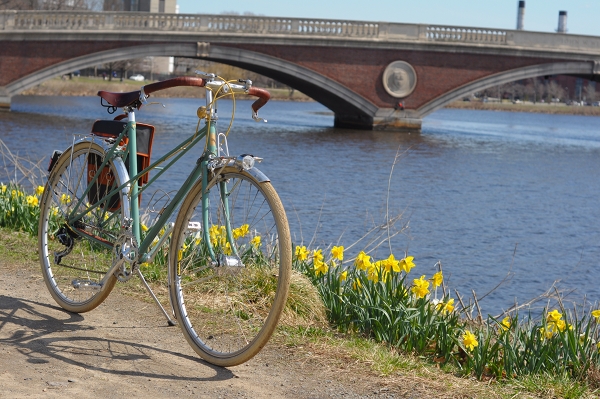 I was having a political discussion with a friend over email, and in response to something I wrote he replied: "You know, it's really starting to show that you haven't been out of the US in almost a year." Ouch... But the "insult" aside, I realised he was correct: I haven't been out of the country since last July, which is unusual for me. Moreover, we have been without a car since December, making our travel radius limited to cycleable distances. Without explicitly being aware of it, I have transitioned from living "globally" to living "locally," and my friend's insinuation was that this has made me narrow-minded and provincial. Has it? I think not, but I also realise that I don't really care. My quality of life has improved as a result of the changes I've made since last year, and that's difficult to argue with.
I was having a political discussion with a friend over email, and in response to something I wrote he replied: "You know, it's really starting to show that you haven't been out of the US in almost a year." Ouch... But the "insult" aside, I realised he was correct: I haven't been out of the country since last July, which is unusual for me. Moreover, we have been without a car since December, making our travel radius limited to cycleable distances. Without explicitly being aware of it, I have transitioned from living "globally" to living "locally," and my friend's insinuation was that this has made me narrow-minded and provincial. Has it? I think not, but I also realise that I don't really care. My quality of life has improved as a result of the changes I've made since last year, and that's difficult to argue with.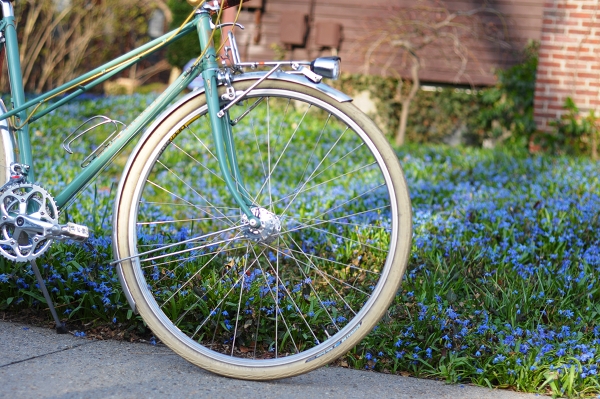 But the issue of living locally vs globally has personal, psychological implications as well, and these have been on my mind lately. I have an unusual personal history, and have basically never lived in any one place for more than several years at a time. As a result, my life has been fragmented and unstable, which I do not feel is ultimately good for me.When I remember things from my past, I sometimes get confused about the location of an event, and even about the language that was spoken.With my friends, relatives, experiences and memories scattered all over the world, it is difficult to maintain a sense of continuity and even a coherent sense of self. Forming healthy attachments to new people and places is challenging, and replacing the physical reality of personal interaction with virtual communications is isolating.
But the issue of living locally vs globally has personal, psychological implications as well, and these have been on my mind lately. I have an unusual personal history, and have basically never lived in any one place for more than several years at a time. As a result, my life has been fragmented and unstable, which I do not feel is ultimately good for me.When I remember things from my past, I sometimes get confused about the location of an event, and even about the language that was spoken.With my friends, relatives, experiences and memories scattered all over the world, it is difficult to maintain a sense of continuity and even a coherent sense of self. Forming healthy attachments to new people and places is challenging, and replacing the physical reality of personal interaction with virtual communications is isolating. I thought that I might feel limited and stir-crazy once I stopped traveling abroad, and even more so once we began living without a car. Instead I am feeling as if some long-neglected human aspect of me is waking up. Living locally and all that it entails - seeing the same people, experiencing the change of seasons while staying put, and developing a feel for manageable distances - is giving me a sense of continuity that I have been lacking.
I thought that I might feel limited and stir-crazy once I stopped traveling abroad, and even more so once we began living without a car. Instead I am feeling as if some long-neglected human aspect of me is waking up. Living locally and all that it entails - seeing the same people, experiencing the change of seasons while staying put, and developing a feel for manageable distances - is giving me a sense of continuity that I have been lacking.
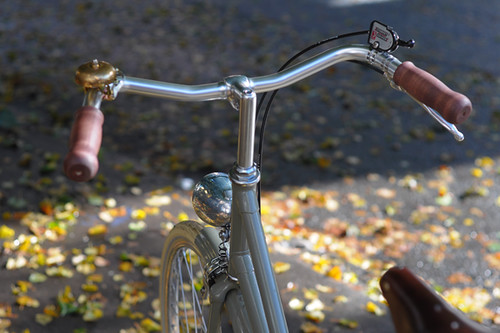 When setting up dynamo lighting on a bicycle with no provisions for it (i.e. no internal routing or special braze-ons), there is always the question of how to route the wiring so that it looks "clean." After all, no one likes to see black wires coiled around a frame's fork and tubes. When setting up the lights on my Rivendell some time ago, the Co-Habitant and I developed a nice method that is practically invisible, and I've been meaning to share it. So when we recently did the same to my Bella Ciao, I made sure to document it.
When setting up dynamo lighting on a bicycle with no provisions for it (i.e. no internal routing or special braze-ons), there is always the question of how to route the wiring so that it looks "clean." After all, no one likes to see black wires coiled around a frame's fork and tubes. When setting up the lights on my Rivendell some time ago, the Co-Habitant and I developed a nice method that is practically invisible, and I've been meaning to share it. So when we recently did the same to my Bella Ciao, I made sure to document it.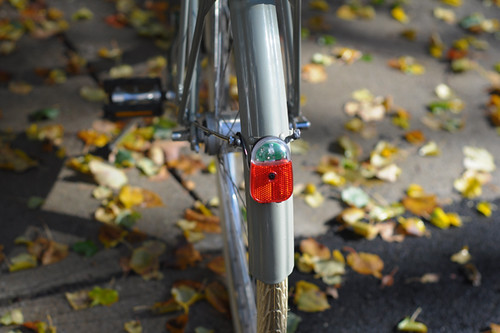 This method assumes that your bicycle is equipped with fenders, and that you are installing both a headlight and tail light. I will also assume that you already know how to connect the lights themselves; this is not meant to be an electrical tutorial.
This method assumes that your bicycle is equipped with fenders, and that you are installing both a headlight and tail light. I will also assume that you already know how to connect the lights themselves; this is not meant to be an electrical tutorial.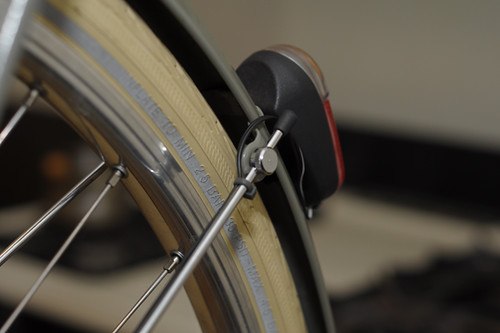 The key to our method is using as little wiring as necessary - running it in a straight line parallel to existing stays and tubes, as opposed to coiling it, and securing it with colour-matched zipties. It's a simple idea, but colour-matched zipties really do blend in with the bicycle when all is said and done. You may be surprised to learn that they are available in all sorts of colours - from bright rainbow hues, to neutrals such as clear, white, cream, taupe and gray. We use small gray zipties to route the wire from the tail light along the non-drivetrain side fender chainstay.
The key to our method is using as little wiring as necessary - running it in a straight line parallel to existing stays and tubes, as opposed to coiling it, and securing it with colour-matched zipties. It's a simple idea, but colour-matched zipties really do blend in with the bicycle when all is said and done. You may be surprised to learn that they are available in all sorts of colours - from bright rainbow hues, to neutrals such as clear, white, cream, taupe and gray. We use small gray zipties to route the wire from the tail light along the non-drivetrain side fender chainstay.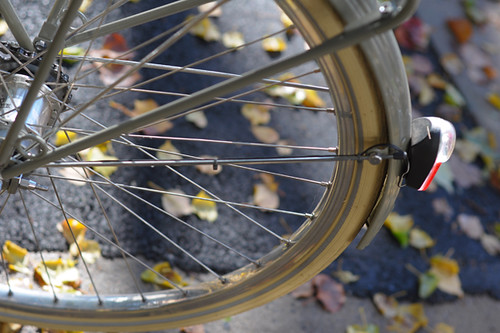 In natural light, the result looks like this.
In natural light, the result looks like this.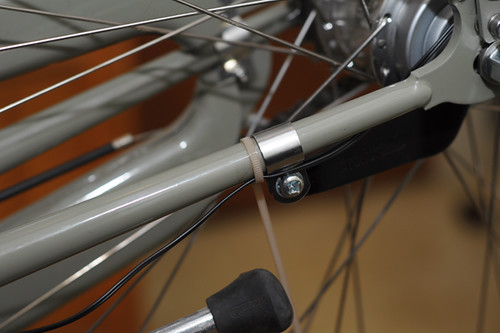 We then proceed along the non-drivetrain side chainstay, using a larger colour-matched ziptie. This frame is a sort of pale military green, and this beige ziptie blends in nicely.
We then proceed along the non-drivetrain side chainstay, using a larger colour-matched ziptie. This frame is a sort of pale military green, and this beige ziptie blends in nicely.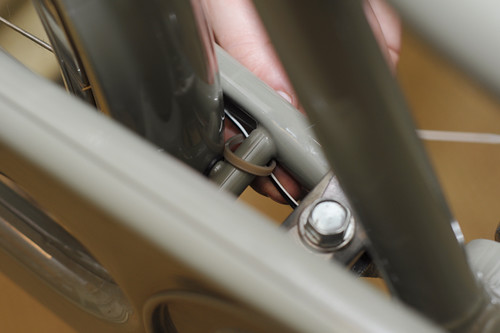 Continuing the same underneath the bottom bracket.
Continuing the same underneath the bottom bracket.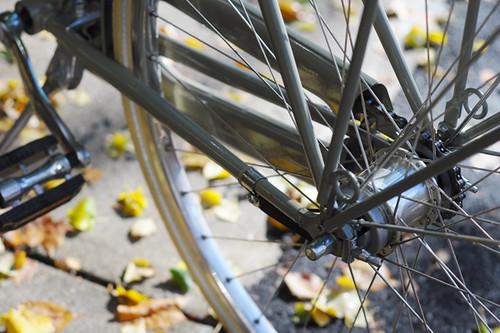 In natural light, the wiring really does "disappear" when routed in this manner, staying close to the chainstay.
In natural light, the wiring really does "disappear" when routed in this manner, staying close to the chainstay.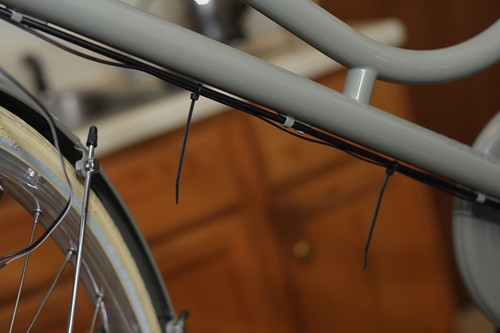 If your frame already has shifter cable braze-ons on the downtube as this one does, then you can simply attach the wiring to the shifter cable itself (small black zipties this time). Otherwise, use two large colour-matched zipties for the dwntube, like we did here.
If your frame already has shifter cable braze-ons on the downtube as this one does, then you can simply attach the wiring to the shifter cable itself (small black zipties this time). Otherwise, use two large colour-matched zipties for the dwntube, like we did here.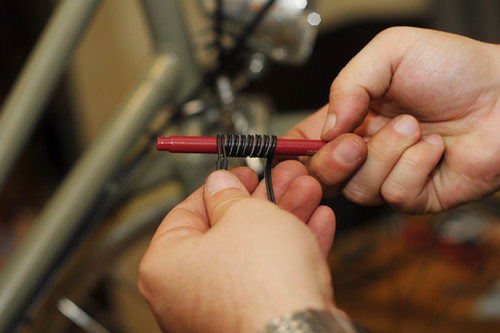 For the headlight, you will need to leave enough wire so that your ability to turn the handlebars is not constricted. We prefer to achieve this by creating a coil here. To do this, simply wrap the wire tightly around a pen or a stick.
For the headlight, you will need to leave enough wire so that your ability to turn the handlebars is not constricted. We prefer to achieve this by creating a coil here. To do this, simply wrap the wire tightly around a pen or a stick. 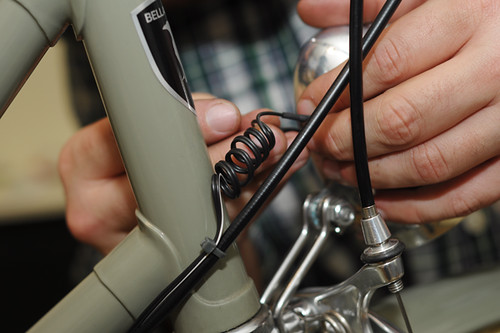 And voila, there is your coil. Notice the additional ziptie along the shifter cable, just to keep everything neatly in place.
And voila, there is your coil. Notice the additional ziptie along the shifter cable, just to keep everything neatly in place.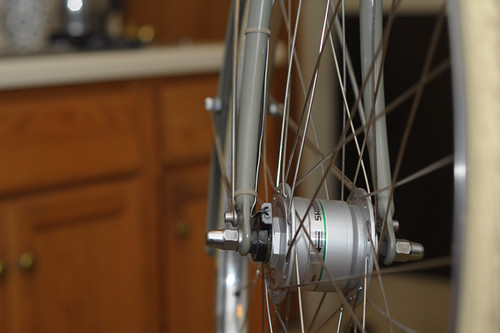 Finally, use the same colour-matched zipties along the fork as you did along the chainstays, routing the wire to the hub as tautly as possible.
Finally, use the same colour-matched zipties along the fork as you did along the chainstays, routing the wire to the hub as tautly as possible.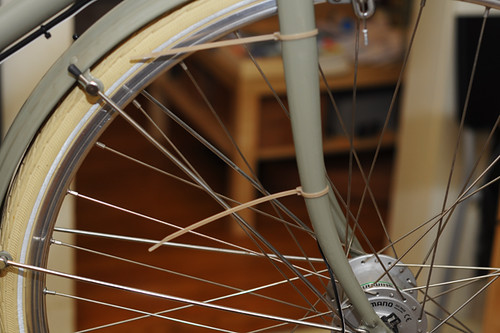 Even frames with internal routing often lack provisions for the fork, and here I find it especially important to find zipties in a colour that blends in with the paint - otherwise it can look as if the fork is cut into pieces, its elegant curvature disturbed. I am using my camera flash to show the process, but in daylight this really looks quite unobtrusive.
Even frames with internal routing often lack provisions for the fork, and here I find it especially important to find zipties in a colour that blends in with the paint - otherwise it can look as if the fork is cut into pieces, its elegant curvature disturbed. I am using my camera flash to show the process, but in daylight this really looks quite unobtrusive.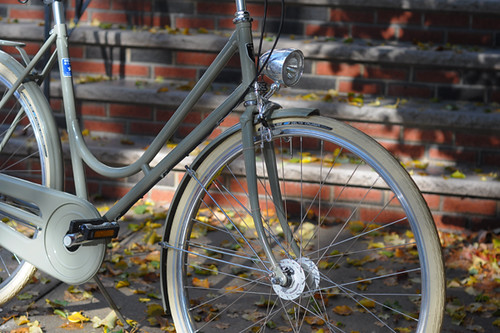 In natural light up close.
In natural light up close.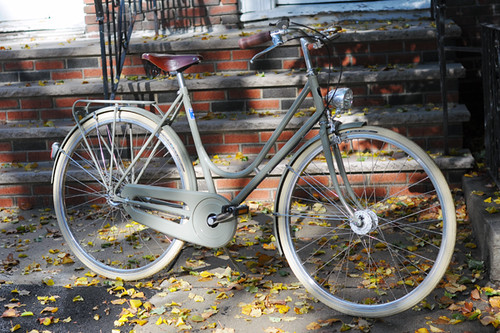 And from further away.
And from further away. 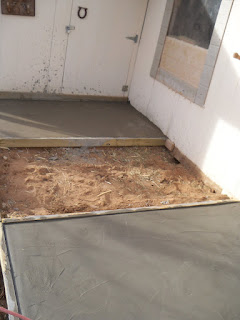
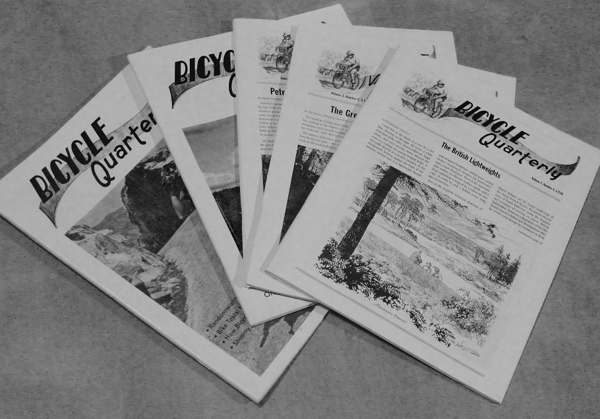 [Edited to add: Bicycle Quarterly became a sponsor of this website in December . This post was written 1 year prior to that time.]
[Edited to add: Bicycle Quarterly became a sponsor of this website in December . This post was written 1 year prior to that time.]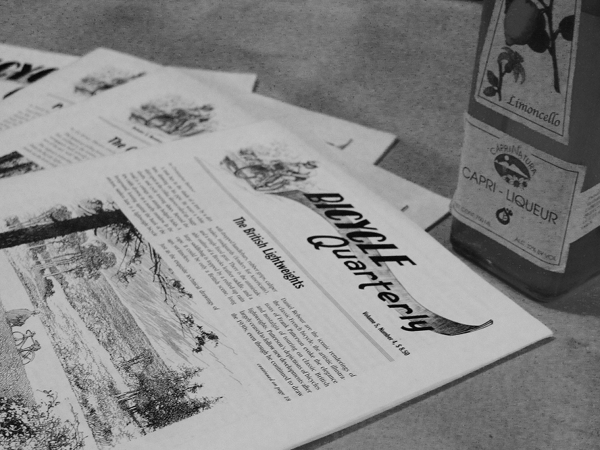 To be sure, the Bicycle Quarterly contains a wealth of carefully researched information, which I find invaluable to my own learning experience. The author is detail-oriented and analytical, conducting in-depth research and getting to the very heart of the matter in every topic he explores. In particular, I have found the rare historical information, and the many articles examining the geometries of classic bicycles extremely useful.The information provided is not something that can easily, if at all, be found online, and so it is a priceless resource. I will be storing these back issues carefully and using them as reference material in the future.
To be sure, the Bicycle Quarterly contains a wealth of carefully researched information, which I find invaluable to my own learning experience. The author is detail-oriented and analytical, conducting in-depth research and getting to the very heart of the matter in every topic he explores. In particular, I have found the rare historical information, and the many articles examining the geometries of classic bicycles extremely useful.The information provided is not something that can easily, if at all, be found online, and so it is a priceless resource. I will be storing these back issues carefully and using them as reference material in the future.


 To ease this pathetic state, I gifted myself a "new" camera (a Rolleicord Ia circa 1941, if that means anything to you). That's the one hanging around my neck with the twin lenses. The one in my hands is a Lumix 3 digital point-and-shoot. And yes, those are bicycles behind me. Ironic, isn't it? I have two bicycles at my disposal... once I have healed enough to ride them, which hopefully will be soon.
To ease this pathetic state, I gifted myself a "new" camera (a Rolleicord Ia circa 1941, if that means anything to you). That's the one hanging around my neck with the twin lenses. The one in my hands is a Lumix 3 digital point-and-shoot. And yes, those are bicycles behind me. Ironic, isn't it? I have two bicycles at my disposal... once I have healed enough to ride them, which hopefully will be soon. [image from Cycling is Good for You]
[image from Cycling is Good for You]


